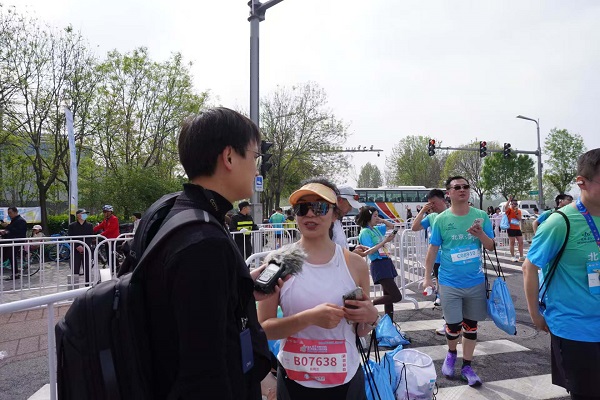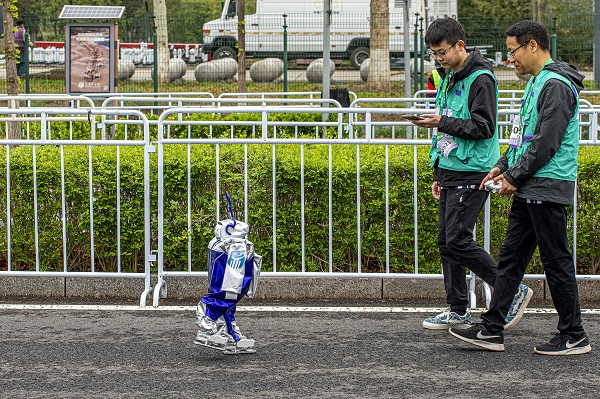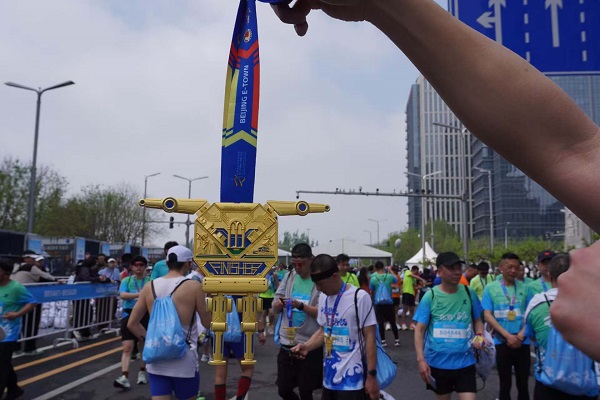2025年4月21日,CGTN(中国国际电视台)报道了我校“0306小巨人”机器人参加全球首个人形机器人半程马拉松比赛的内容,以下是全文:
The world’s first Human-Robot Half Marathon has made history.
The groundbreaking event in Beijing brought together human athletes and humanoid robots on the same course—testing the limits of engineering and endurance.
While only a fraction of the robot field completed the course, experts say the implications go far beyond the finish line.

Tiangong Ultra crosses the finish line at the world’s first Humanoid Robot Half Marathon in Yizhuang, Beijing. [Photo: VCG]
Although humans and robots raced in separate lanes, the event posed unprecedented challenges for the machines—requiring them to navigate real-world conditions like uneven terrain, steep inclines, and 14 sharp turns. It was the first time robots faced such a course in a competitive setting.
To support their efforts, organizers allowed for battery swaps and even robot substitutions mid-race. Dedicated service stations along the route provided both technical and medical assistance.
Among the standout performers was Tiangong Ultra—a 1.8-meter-tall, 55-kilogram humanoid robot that completed the 21-kilometer course in 2 hours and 40 minutes, finishing first among the robot competitors.
“Running with robots was eye-opening. I think they’ll surpass human limits soon.”
“This feels like early testing, but true human-robot racing might be just around the corner.”

Zhang Fenglan (R), a participant in the world’s first Humanoid Robot Half Marathonin Yizhuang, Beijing, is interviewed by CGTN Radio. [Photo: CGTN Radio]
Out of around 20 robotic participants, only six crossed the finish line. But behind each entry were important technical breakthroughs in robotics design, control systems, and real-time decision-making.
One team that drew attention was from Beijing Polytechnic University. Their robot, 0306 Little Giant, stood just 75 centimeters tall and weighed 10 kilograms. Its small stature and cheerful appearance belied a sophisticated design.
“We designed the upper body to be lightweight, lowering the center of gravity for better stability and improving battery life.”
"0306 Little Giant" showcases its interactive functions at Beijing Polytechnic University. [Video: CGTN Radio]
Despite not tiring like human runners, robots faced complex physical demands. To stay upright and responsive, many relied on predictive algorithms.
“Our team used Model Predictive Control technology. Simply put, the algorithm predicts the robot's next movement and adjusts its posture in advance to maintain stability.”

“0306 Little Giant” hits the track at the world’s first Humanoid Robot Half Marathon in Yizhuang, Beijing. [Photo: VCG]
Some robots required remote control, adding an extra layer of difficulty. For operators like Ren Tianci, the event was the result of intense preparation.
“We trained daily on campus to practice remote operations. Just getting our first robot race-ready took over two weeks of continuous testing and adjustments.”

The medal from the world’s first Humanoid Robot Half Marathon in Yizhuang, Beijing, features a robotic design, reflecting the event’s unique inclusion of humanoid robot participants. [Photo: CGTN Radio]
For now, the Human-Robot Half Marathon is less about competition and more about collaboration—between minds and machines, humans and their creations.
But the significance of this race goes well beyond athletics. Team member Cheng Xuemei highlighted the broader applications of the technologies involved.
“These technologies have the potential to serve beyond athletics. We’re looking at use cases in elder care, industrial automation, and hazardous environments—anywhere robots can take on tasks too dangerous or physically demanding for humans.”
According to the 2025 Humanoid Robotics and Embodied Intelligence Industry Report, China is expected to produce more than 10,000 humanoid robots in the near future. The domestic market alone is projected to exceed 1.1 billion US dollars—more than half of the global share.
【CGTN】Running into the future: robots compete in half marathon

